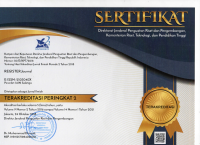Developing video-conferenced English speaking test (VEST) for classroom-based assessment in tertiary education
Abstract
Keywords
Full Text:
PDFReferences
Alderson, J.C., and Banerjee, J. (2002). Language testing and assessment (Part 2). Language Teaching, 35, 79–113. https://doi.org/10.1017/S0261444802001751
Bachman, L.F., and Palmer, A.S. (1996). Language testing in practice. Oxford: Oxford University Press. https://octovany.files.wordpress.com/2013/12/language-testing-in-practice-bachman-palmer.pdf
Byrne, G., and Staehr, L. (2002, June). International internet-based videoconferencing in distance education – a low cost option. Paper presented at the Informing Science IT Education Conference Proceedings, Information Science Institute, California, USA. https://doi.org/10.28945/2451 .
Chapelle, C. (1994). Are C-tests valid measures for L2 vocabulary research? Second Language Research, 10, 157–187. https://doi.org/10.1177/026765839401000203
Council of Europe. (2001). Common European Framework of Reference for Languages: Learning, Teaching, Assessment. Council of Europe. https://www.coe.int/en/web .
Craig, D.A., and Kim, J. (2010). Anxiety and performance in videoconferenced and face-to-face oral interviews. Multimedia-Assisted Language Learning, 13, 9–32. https://doi.org/10.15702/MALL.2010.13.3.9 .
Field, J. (2011). Cognitive validity. In L. Taylor (Ed.), Examining speaking: Research and practice in assessing second language speaking (Studies in Language Testing, Vol. 30) (pp. 65–111). Cambridge, UK: Cambridge University Press. http://hdl.handle.net/10547/338249 .
Galaczi, E. D. (2010). Face-to-face and computer-based assessment of speaking: Challenges and opportunities. In L. Araújo (Ed.), Computer-based assessment of foreign language speaking skills (pp. 29–51). Luxemburg: European Union. https://www.researchgate.net/publication/281090096 .
Galaczi, E. D., Ffrench, A., Hubbard, C, and Green, A. (2011). Developing assessment scales for large-scale speaking tests: a multiple-method approach. Assessment in Education: Principles, Policy and Practice, 18(3), 217-237. http://dx.doi.org/10.1080/0969594X.2011.574605
Grayson, D., and Monk, A. (2003). Are you looking at me? Eye contact and desktop video conferencing. ACM Transactions on Computer-Human Interaction (TOCHI), 10(3), 221–243. http://dx.doi.org/10.1145/937549.937552 .
Gruba, P. (1997). The role of video media in listening assessment. System, 25, 335–345. https://doi.org/10.1016/S0346-251X(97)00026-2 .
Heins, B., Duensing, A., Stickler, U., and Batstone, C. (2007). Spoken interaction in online and face-to-face language tutorials. Computer Assisted Language Learning, 20(3), 279–295. http://dx.doi.org/10.1080/09588220701489440 .
Hirai, A., and Koizumi, R. (2009). Development of a practical speaking test with a positive impact on learning using a story retelling technique. Language Assessment Quarterly, 6(2), 151-167. http://dx.doi.org/10.1080/15434300902801925
Kehoe, M., Niederberger, N., and Bouchut, A-L. (2021). The development of a speech sound screening test for European French-speaking monolingual and bilingual children. International Journal of Speech-Language Pathology, 23(2), 135-144. https://doi.org/10.1080/17549507.2020.1750699
Kenyon, D., and Malabonga, V. (2001). Comparing examinee attitudes toward computer-assisted and other proficiency assessments. Language Learning and Technology, 5(2), 60–83. http://dx.doi.org/10125/25128
Kiddle, T., and Kormos, J. (2011). The effect of mode of response on a semidirect test of oral proficiency. Language Assessment Quarterly, 8(4), 342–360. doi:10.1080/15434303.2011.613503.
Kim, J.T. (2006). The effectiveness of test-takers’ participation in development of an innovative web-based speaking test for international teaching assistants at American colleges (Unpublished doctoral dissertation). University of Illinois at Urbana-Champaign. https://www.proquest.com/docview/622019942 .
Kim, J., & Craig, D. A. (2012). Validation of a videoconferenced speaking test. Computer Assisted Language Learning, 25(3), 257–275. https://doi:10.1080/09588221.2011.649482 .
Lee, L. (2007). Fostering second language oral communication through constructivist interaction in desktop videoconferencing. Foreign Language Annals, 40, 635–649. http://dx.doi.org/10.1111/j.1944-9720.2007.tb02885.x
Messick, S. (1989). Validity. In R.L.Linn (Ed.), Educational measurement (pp. 13–103). New York: Macmillan. https://doi.org/10.3102/0013189X018002005 .
Nakatsuhara , F., Inoue, C., and Taylor, L. (2020): Comparing Rating Modes: Analysing Live, Audio, and Video Ratings of IELTS Speaking Test Performances, Language Assessment Quarterly. https://doi.10.1080/15434303.2020.1799222
O’Sullivan, B., Weir, C. J., and Saville, N. (2002). Using observation checklists to validate speaking-test tasks. Language Testing, 19(1), 33–56. doi:10.1191/0265532202lt219oa
Schreiber, L. M., Paul, G. D., and Shibley, L. R. (2012). The development and test of the public speaking competence rubric. Communication Education, 61(3), 205-233. http://dx.doi.org/10.1080/03634523.2012.670709
Schwandt, T.A., and Halpern, E.S. (1988). Linking auditing and meta evaluation. Newbury Park, CA: Sage. https://doi.org/10.1177/109821408901000405 .
van Moere, A. (2012). A psycholinguistic approach to oral language assessment. Language Testing, 29(3), 325–344. doi:10.1177/0265532211424478
Wagner, E. (2007). Are they watching? Test-taker viewing behavior during an L2 video listening test. Language Learning and Technology, 11(1), 7–8. http://dx.doi.org/10125/44089
Wainfan, L., and Davis, P.K. (2004). Challenges in virtual collaboration: videoconferencing, audio conferencing, and computer-mediated communications. Santa Monica, CA: RAND Corporation. https://www.rand.org/content/dam/rand/pubs/monographs/2004/RAND_MG273.pdf
Wang, Y. (2004). Supporting synchronous distance language learning with desktop videoconferencing. Language Learning and Technology, 8(3), 90–121. http://dx.doi.org/10125/43997
Wang, Y. (2006). Negotiation of meaning in desktop videoconferencing-supported distance language learning. ReCALL, 18(1), 122–146. http://dx.doi.org/10.1017/S0958344006000814 .
Weir, C. J., Vidakovic, I., and Galaczi, E. (2013). Measured constructs (Studies in Language Testing, Vol. 37). Cambridge, UK: Cambridge University Press. http://hdl.handle.net/10547/338250.
Whitehead, J. (1989). Creating a Living Educational Theory from Questions of the Kind, ‘How do I Improve my Practice?’ Cambridge Journal of Education, 19(1), 41–52. https://doi.org/10.1080/0305764890190106
Xiao, M. (2007). An empirical study of using internet-based desktop videoconferencing in an EFL setting (Unpublished dissertation). Ohio University. http://rave.ohiolink.edu/etdc/view?acc_num=ohiou1194703859
DOI: http://dx.doi.org/10.30659/e.8.1.242-262
Refbacks
- There are currently no refbacks.
Copyright (c) 2023 David Imamyartha, Mutiara Bilqis, Areta Puspa, Rizki Febri Andika Hudori, Eka Wahjuningsih
License URL: https://creativecommons.org/licenses/by/4.0/










